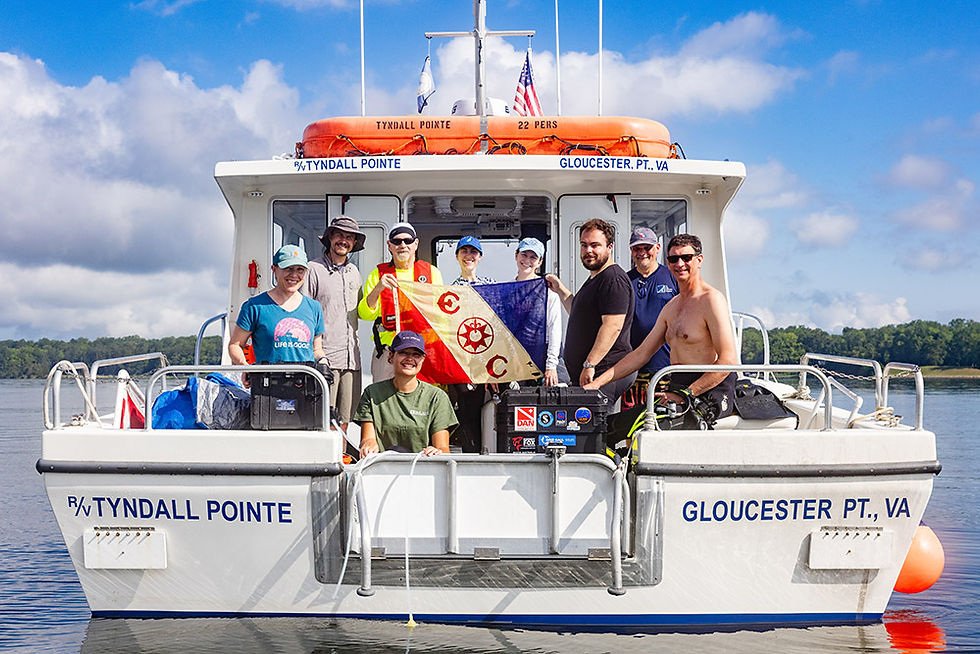Where Science Meets Hope: Pikitch Drives Global Change from Shinnecock to the Chesapeake
- IOCS Team

- Oct 13
- 4 min read

October 13, 2025
When the Chesapeake Bay was officially named a Mission Blue Hope Spot in June, Stony Brook University’s Ellen Pikitch saw it as proof that “hope begets hope.”
Pikitch, a professor in the School of Marine and Atmospheric Sciences (SoMAS) and executive director of the Institute for Ocean Conservation Science (IOCS), played a key role in expanding the Hope Spot concept from Long Island’s Shinnecock Bay, designated in 2022, to the Chesapeake. “The Shinnecock Bay Hope Spot showed that restoration and collaboration can make a measurable difference,” she said. “The success there inspired others to try to replicate that hope somewhere new.”
Hope Spots, founded by renowned marine biologist Sylvia Earle and her organization Mission Blue, recognize areas around the globe that are critical to the ocean’s health. Each Hope Spot is championed by individuals or organizations who lead efforts to protect and restore those ecosystems. For the Chesapeake Bay, the new champions are The Explorers Club and the University of Maryland Eastern Shore.
“The Chesapeake Bay and Shinnecock Bay share many similarities,” Pikitch said. “They’re both estuarine systems that open to the Atlantic, they’ve both suffered from pollution and habitat loss, and they both rely on oysters and clams that once thrived but have declined over time.”

Pikitch’s leadership in the Shinnecock Bay restoration and her partnership with the Shinnecock Nation served as a model for the Chesapeake Bay. “When we started with Shinnecock Bay, the water quality was poor, harmful algal blooms were frequent, and the ecosystem was in decline,” she said. “Through science, restoration efforts, collaboration, and community involvement, we turned things around. We showed that it’s possible to make change, and not just hope for change.”
The Chesapeake Bay presents challenges on a much larger scale. “It’s enormous, involving several states and many different tribes, communities, and stakeholders,” Pikitch said. “But that also means it has incredible potential to unite people around a shared goal.”
Pikitch helped lay the groundwork for the new designation as part of a committee The Explorers Club convened that spent two years building support for the Chesapeake Bay proposal. “We had weekly Zoom calls with scientists, policy makers, tribal representatives, and local organizations,” she said. “By the end, we had about 25 letters of support from a wide range of groups, including the National Aquarium, the Maritime Museum, and Indigenous leaders. It was a huge effort.”
That Indigenous engagement was essential. “Mission Blue made it clear from the beginning that having support from the Indigenous communities of the region was critical,” Pikitch said. “We worked closely with the Rappahannock Tribe and the Indigenous Conservation Council of the Chesapeake Bay, which represents several tribes in the Chesapeake region.”
The Shinnecock Nation’s earlier collaboration with Pikitch’s team helped inspire the Rappahannock to join. “They wanted to understand why the Shinnecock decided to work with us,” she said. “Once they saw how the partnership had evolved and the respect we had for Indigenous knowledge, they agreed to be part of it too.”
Much of Pikitch’s current research centers on environmental DNA (eDNA), a technology that detects traces of genetic material organisms leave in water. “It’s an incredibly powerful and noninvasive tool,” she said. “By collecting water samples, we can identify species that are present without ever disturbing them. It’s also aligned with the Indigenous principle of ‘least harm,’ which is one of the reasons this work resonates so strongly with our tribal partners.”
Her team’s eDNA work in Shinnecock Bay has already transformed how scientists monitor marine biodiversity. “In more than a decade of traditional sampling, we identified four species of sharks, skates, and rays,” Pikitch said. “With just one year of eDNA sampling, we found twelve. That shows how much life we were missing using older methods.”
The Chesapeake Bay expedition that helped support the Hope Spot application built directly on those methods. Co-led by Stony Brook alumnus Stephen Tomasetti (PhD ‘22), now an assistant professor and director of the Paul. S. Sarbanes Coastal Ecology Center at the University of Maryland Eastern Shore, the research combined underwater surveys with eDNA sampling.
“The Chesapeake Bay Hope Spot really captures what my lab is all about: connecting science and community to make coastal systems more resilient,” said Tomasetti. “Whether it’s oyster reefs or seagrass meadows, every restoration success reminds us that hope is something we build together.”
One of Pikitch’s doctoral students, Natalia Benejam, participated in the fieldwork with Tomasetti. “It’s really come full circle,” Pikitch said. “Stephen learned restoration techniques here at Stony Brook and is now leading them at Chesapeake Bay. That’s the kind of ripple effect we hope to create.”
The announcement of the Chesapeake Bay’s new status took place at The Explorers Club in New York during World Oceans Week, where Rappahannock Chief Anne Richardson offered a blessing. “It was a wonderful moment of unity,” Pikitch said. “People from all these different communities came together to celebrate what this designation means.”
The new Hope Spot represents expansion of the work that began in Shinnecock Bay for Pikitch. “What we’ve done in Shinnecock Bay serves as a blueprint,” she said. “Now we’re sharing that knowledge, our technology, our partnerships, and our experience, with a region that affects millions of people and thousands of species.”
“This also shows that our work at Stony Brook has reached far beyond Long Island,” said Pikitch. “What started here has sparked hope in one of the most important estuaries in the world. That’s something we can all be proud of.”
“The Hope Spot framework creates space for optimism,” she said. “It recognizes that while our oceans are under stress, they are also resilient if we act in time. The Chesapeake Bay is a living example of that potential.”
— Beth Squire




Comments